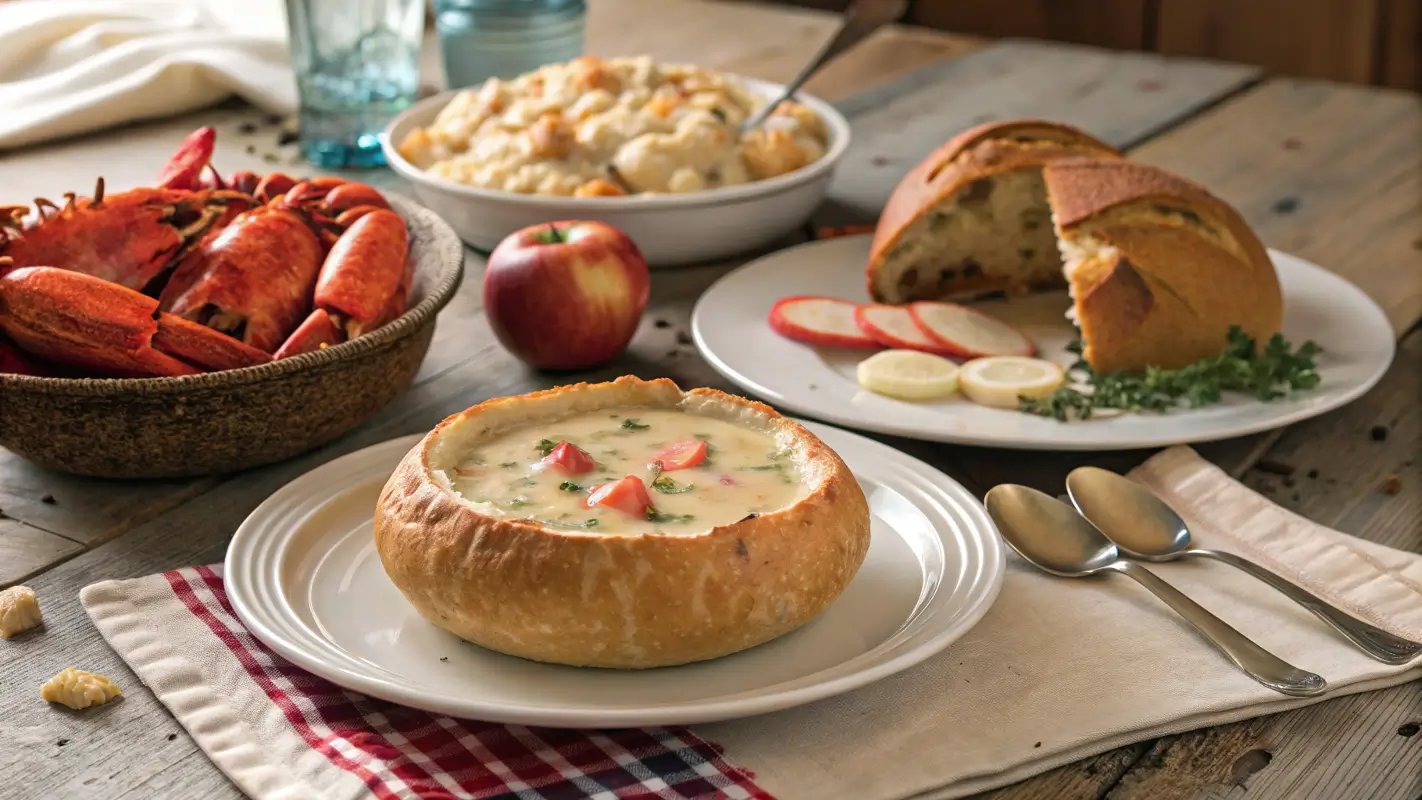Table of Contents
Introduction to New England Cuisine
New England, located in the northeastern corner of the United States, boasts a culinary heritage that is as rich and diverse as its scenic landscapes. From the rugged coastlines to the quaint countryside, this region is home to some of the most beloved and time-honored dishes in American cuisine. But what exactly makes New England food so special?
New England cuisine is deeply rooted in its history, shaped by Indigenous people, early settlers, and immigrant communities. The flavors here are hearty, with an emphasis on fresh, local ingredients — think seafood, corn, potatoes, and maple syrup. So, whether you’re indulging in a creamy bowl of clam chowder or savoring the sweetness of blueberry pie, New England’s food is all about comforting, satisfying meals that tell a story.
Let’s take a deep dive into the signature dishes that define this region, from clam chowder to lobster rolls, and discover how centuries of tradition come together to make New England cuisine unforgettable.
Signature Dishes of New England Cuisine
Clam Chowder
Origin and Evolution
Arguably the most iconic dish to come out of New England, clam chowder is a creamy, rich soup made with fresh clams, potatoes, onions, and celery. The origins of clam chowder can be traced back to the early settlers of New England, who created the dish using local ingredients. While there are different types of chowders across the world, New England’s version stands out for its velvety, milk-based broth, often thickened with a bit of flour or cream.
Over the years, clam chowder has undergone several variations. Some versions use butter and salt pork for extra richness, while others may feature vegetables like leeks or carrots for a slight twist. However, the core elements — clams and cream — remain the heart of this dish.
Traditional Recipe and Variations
A traditional New England clam chowder starts with a base of butter, onions, and celery. Then, potatoes, clams, and heavy cream are added to create that signature creamy texture. Often topped with crispy crackers or a sprinkle of parsley, it’s the perfect dish for a chilly evening by the sea.
For a spicier take, some cooks add a bit of cayenne pepper or hot sauce, while others play around with the ratio of potatoes to clams for different textures. If you’re looking to make it at home, don’t forget that fresh clams are key — you can even try using clam juice for a more intense flavor.
Looking for a clam chowder recipe? Check out clam chowder recipe for a comforting dish.
Lobster Rolls
History and Cultural Significance
Another hallmark of New England cuisine is the lobster roll. This simple yet decadent sandwich is made by stuffing lobster meat into a soft, buttered bun. For many, it’s the quintessential New England dish, representing the region’s close ties to the sea.
The lobster roll has its roots in Maine, where lobster fishing is a centuries-old tradition. The sandwich became popular in the 1920s, when roadside shacks and local seafood restaurants began offering it to tourists. Today, it’s a staple of New England summers, often served with a side of crispy fries and a pickle spear.
Preparation Methods
There are two main variations of the lobster roll: the Maine lobster roll, which is served with lobster meat, mayo, and a bit of lemon on a toasted bun, and the Connecticut lobster roll, which is served warm with butter instead of mayo. Both styles highlight the sweet, tender lobster meat, but the debate over which version is superior continues to be a beloved (and sometimes heated) New England tradition!
Baked Beans
Colonial Roots and Regional Differences
The beloved baked beans of New England are not just any beans — they have a history that stretches back to the region’s colonial days. Early Native Americans introduced European settlers to this hearty dish, combining beans with maple syrup, molasses, and herbs to create a flavorful, slow-cooked comfort food. Over time, the recipe was adapted by settlers, who added salt pork and other ingredients for a heartier, meatier version.
Interestingly, baked beans in New England were once considered a staple for Sunday meals. The slow cooking method meant that they could be prepared in advance, allowing families to focus on other chores or activities. The beans were often enjoyed with fresh cornbread, making it a true “comfort meal” of the region.
Classic Recipes
The classic New England baked beans recipe often calls for navy beans, which are small and tender when cooked. The dish is baked slowly with a generous amount of molasses, creating a rich, deep sweetness, with a hint of smokiness from the salt pork. While some recipes add mustard or cloves for extra depth, the core of the dish remains simple and satisfying.
For a vegetarian twist, you can skip the pork and replace it with vegetable broth or even a little liquid smoke for flavor. Either way, you’ll be savoring a taste of New England’s history.
Iconic New England Desserts
Boston Cream Pie
Origin and Recipe
While Boston Cream Pie is technically a cake, it has earned its place as one of the most iconic New England desserts. This creamy, decadent treat was created in the 1800s at the Omni Parker House Hotel in Boston. Originally called a “Parker House cake,” the dessert features layers of sponge cake filled with rich custard or pastry cream and topped with a glossy layer of chocolate glaze.
Today, Boston Cream Pie is synonymous with New England, often served at local bakeries and restaurants. The beauty of this dessert lies in its simplicity: the tender cake, luscious custard filling, and velvety chocolate topping come together to create a dessert that has become beloved nationwide.
Preparation and Serving
The traditional preparation involves making a light sponge cake, allowing it to cool, and then filling it with a rich custard made from eggs, milk, and sugar. After chilling the cake, it’s topped with a layer of melted chocolate, creating a luxurious finish. While the recipe remains a favorite, modern variations can include whipped cream or fruit as an added garnish.
Indian Pudding
Historical Background
If you’re looking for a dessert that truly reflects the history of New England, look no further than Indian pudding. This dessert, which dates back to the colonial era, is a sweet, spiced pudding made from cornmeal, molasses, and milk. It was originally created by Native Americans, who taught the settlers how to cook with corn and other local ingredients.
Indian pudding is a nod to the blending of cultures in New England, with its Native American origins combined with European influences. It’s a comforting dessert that was often prepared for special occasions, though it’s still enjoyed today as a nostalgic treat.
Preparation and Serving Suggestions
The traditional recipe for Indian pudding involves cooking cornmeal with milk, molasses, and spices like cinnamon and nutmeg, and then baking the mixture until it thickens into a custard-like consistency. Some recipes call for eggs to be added for richness. The pudding is typically served warm, often with a scoop of vanilla ice cream or a drizzle of cream on top. It’s the perfect dish for a chilly New England evening!
Blueberry Pie
Significance in New England
New Englanders are proud of their blueberry pie, a dessert that highlights the region’s abundant summer blueberry harvest. Blueberries have grown in New England since colonial times, and today, Maine is the nation’s largest producer of wild blueberries. This pie is a staple at summer gatherings, family picnics, and local fairs.
Not only does blueberry pie showcase the bounty of the region, but it also evokes memories of picking fresh berries in the wilds of New England. With a buttery, flaky crust and a sweet, tangy filling, this dessert is beloved by locals and visitors alike.
Traditional Recipe
To make a traditional New England blueberry pie, fresh blueberries are mixed with sugar, lemon juice, and a bit of cornstarch or flour to thicken the filling. The mixture is poured into a prepared pie crust and baked until golden and bubbly. Many families have their own variations, with some adding a sprinkle of cinnamon or nutmeg for extra warmth.
This pie is typically served with a dollop of whipped cream or a scoop of vanilla ice cream, making it a perfect summer dessert.
Beverages and Sweets
Maple Syrup
Production Process
One of the quintessential flavors of New England is maple syrup. This sweet treat is harvested from sugar maple trees, primarily in the northern regions of New England, where the cold winters and warm springs create the perfect conditions for sap to flow. The process of making maple syrup involves tapping the trees in early spring, collecting the sap, and then boiling it down to create the syrup.
The production of maple syrup is a labor-intensive process that has been passed down for generations. New England’s maple syrup is known for its rich, deep flavor, and it’s often used in baking, cooking, or simply drizzled over pancakes or waffles.
Culinary Uses
Maple syrup is a versatile ingredient in New England cuisine. It can be used to sweeten everything from baked beans to blueberry pie. In fact, many traditional recipes call for maple syrup to replace sugar, adding a unique depth of flavor. Maple butter, made by whipping maple syrup with butter, is also a popular spread for breads and muffins.
Apple Cider
Historical Importance
Apple cider has been a staple beverage in New England for centuries, thanks to the abundance of apple orchards in the region. New England’s cool climate provides the perfect environment for growing apples, and cider-making has been a time-honored tradition passed down through generations. Apple cider, often spiced with cinnamon and cloves, is a comforting drink, especially in the fall when apples are at their peak.
Modern Variations
Today, apple cider can be found both in its traditional, unfiltered form and as a more modern, sparkling version. In the fall, hot apple cider spiced with cloves and cinnamon is a popular treat, while hard cider, made by fermenting apple juice, has gained popularity as an alternative beverage.
Fluffernutter Sandwich
Cultural Impact
While not as old as some of New England’s other treats, the Fluffernutter sandwich has become a beloved food item. This sandwich consists of marshmallow fluff spread on bread, typically with peanut butter. It was invented in Massachusetts and has since become a nostalgic favorite for many New Englanders.
Though it might sound simple, the Fluffernutter represents a uniquely regional dish that’s easy to make and loved by children and adults alike.
Recipe and Variations
Making a Fluffernutter is as simple as spreading marshmallow fluff and peanut butter on two slices of bread, though some people like to add slices of banana or even drizzle some honey for a twist. It’s the kind of comfort food that New Englanders grow up with, and for many, it’s a taste of home.
The Influence of Immigrant Cuisines in New England
Italian Influence: Pizza, Pasta, and More
Origins of Italian-American Cuisine in New England
New England’s Italian-American food culture dates back to the late 19th and early 20th centuries when large waves of Italian immigrants settled in the region. As they brought their culinary traditions with them, they adapted them to the ingredients available in their new home. The hearty, flavorful Italian dishes such as pizza, pasta, and gnocchi became intertwined with New England’s culinary identity, and they continue to be staples of the region’s food scene today.
The influence of Italian-American cuisine is particularly visible in Boston, which is home to some of the best pizzerias in the U.S. New Haven-style pizza, which hails from Connecticut, is also popular in the region, known for its thin, crispy crust and unique toppings.
Popular Dishes and Regional Variations
One of the most beloved Italian-American dishes in New England is spaghetti and meatballs. The dish, often served with a side of garlic bread, is a simple yet satisfying meal that is enjoyed by many families. Pizza is another iconic dish, with each New England state boasting its own regional variations. For example, New Haven-style pizza or “apizza,” features a thin, charred crust and distinctive toppings like clams or Italian sausage.
Irish Influence: Stews, Potatoes, and More
The Role of the Irish Immigrants in New England
The Irish have had a profound influence on New England’s food culture, particularly in areas like Boston and Providence. When Irish immigrants arrived in the 19th century, they brought with them a variety of dishes that have become central to the region’s food traditions. The Irish potato played a significant role in many of these recipes, as potatoes were a key ingredient in the immigrants’ diets due to their versatility and low cost.
Corned beef and cabbage became a popular dish in New England, especially around St. Patrick’s Day, but Irish stews and hearty potato-based dishes also became part of the regional food repertoire.
Classic Irish Dishes in New England
While corned beef and cabbage may be the most well-known dish, the Irish also introduced a variety of stews, soups, and casseroles to New England’s food scene. Irish lamb stew is a comfort food that features tender lamb, potatoes, carrots, and onions, often cooked for hours to create a deeply flavorful broth.
The humble potato also plays a starring role in many New England dishes, such as mashed potatoes, potato salad, and potato chowder — all dishes that reflect the Irish influence in the region.
New England Seafood Delights
Fish and Chips: A New England Staple
History of Fish and Chips in New England Cuisine
One of the most quintessential seafood dishes in New England is fish and chips. Though originally a British dish, it became a staple of the region’s coastal cuisine after English settlers and fishermen introduced it to New England. Today, fish and chips are found in nearly every New England seafood shack and restaurant, offering fresh, crispy battered fish served with golden fries.
The fish most commonly used for this dish in New England is cod, thanks to the abundance of this fish along the New England coastline. The crispy batter and flaky fish, combined with the classic side of fries, make for a comforting meal enjoyed by locals and tourists alike.
Preparation and Variations
The key to a great plate of fish and chips is fresh fish, typically cod or haddock, which is battered and deep-fried until golden brown. The fries are often thick-cut, providing a hearty side to complement the fish. Many local seafood shacks add their own twist by serving fish and chips with different types of sauces, like tartar sauce, malt vinegar, or even lemon aioli.
Lobster Bake: A Traditional New England Feast
What is a Lobster Bake?
A lobster bake is a quintessential New England tradition, especially during the summer months. This social and communal meal involves cooking lobster, clams, corn on the cob, and potatoes in a large pot or over an open flame. The food is often prepared outdoors, adding to the festive atmosphere of the event.
The cooking process itself is quite unique, as the ingredients are layered and then steamed together, allowing the flavors to meld. The lobster is typically served alongside melted butter, and many families enjoy their lobster bake with a side of fresh bread and coleslaw.
How to Host a Lobster Bake
Hosting a lobster bake requires a bit of preparation, but it’s a fun and memorable experience for friends and family. To start, you’ll need a large, deep pot or a lobster bake pit if you’re hosting outdoors. The seafood is layered with seaweed, potatoes, corn, and seasoning before being steamed. A typical lobster bake also includes clam chowder or another New England soup, making it a full, satisfying meal. Whether you’re enjoying it on the beach or in your backyard, a lobster bake is one of the best ways to experience New England’s coastal cuisine.
Clams and Mussels: A New England Coastal Classic
The Importance of Clams in New England Cuisine
No discussion of New England seafood would be complete without mentioning clams. Known for their sweet, tender meat, clams are a staple of New England’s coastal cuisine. From clam chowder to steamers, clams are prepared in a variety of ways to create the perfect seafood dish.
Steamed clams, served with melted butter and often paired with a side of fried clams, are a must-try dish for anyone visiting New England. Stuffed clams, which are clams stuffed with a savory mixture of breadcrumbs, herbs, and spices, are another popular variation.
Mussels: A Delicate Seafood Delight
Mussels are another popular seafood item in New England. Often steamed with garlic, white wine, and herbs, mussels are served in a flavorful broth that’s perfect for dipping crusty bread. Many restaurants also serve mussels as an appetizer or entrée, sometimes accompanied by french fries or a side salad.
New England Food Festivals and Celebrations
A Celebration of the Region’s Seafood
New England’s coastal culture is celebrated each year with the New England Seafood Festival, a vibrant event that showcases the best of the region’s seafood. This festival is a great way to sample local dishes like lobster rolls, clam chowder, and fried fish while enjoying live music and entertainment.
The New England Seafood Festival is a must-visit for food lovers and tourists who want to experience New England’s culinary heritage in a fun and lively setting. Many of the area’s top seafood restaurants participate, providing a wide variety of dishes to try.
What to Expect at the Festival
From lobster rolls to fried clams, there’s something for everyone at the New England Seafood Festival. Attendees can also enjoy cooking demonstrations, seafood tastings, and fresh seafood directly from local fishermen. It’s a great way to experience the flavors of New England in one place.
Apple Festival in New England Cuisine
The Apple Harvest Tradition
Fall in New England means apple harvest season, and the Apple Festival is a beloved celebration of the region’s apple-growing heritage. Apples have been a major part of New England’s food culture for centuries, and the Apple Festival is the perfect place to sample everything from apple cider to apple pie.
Activities and Highlights
The Apple Festival is filled with family-friendly activities like apple picking, pie-baking contests, and live entertainment. It’s a fun way to celebrate the harvest and taste all things apple. Don’t forget to try the fresh apple cider donuts, a popular treat during the festival!





